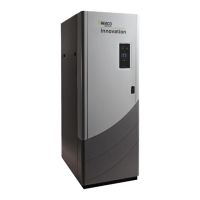Innovation - Edge [i] Installation, Operation, Maintenance Manual
CHAPTER 6 – MAINTENANCE
OMM-0143_A • GF-216 • 9/6/2019 Technical Support • (800) 526-0288 • Mon-Fri, 8 am - 5 pm EST Page 94 of 170
6.11.2 Low Water Cutoff (LWCO) - Standard Test
Perform the standard Low Water Cutoff test using the
Edge
Controller as described below.
Standard Low Water Cutoff Edge Test Instructions
1.
Turn on the AC power to the unit.
2.
Press the
TEST
switch on the Edge Controller and confirm that the blinking "Low Water
Level" message appears
on the Edge display within 4 seconds.
3.
Press the
RESET
key, followed by the
Clear
button, and confirm that the "Low Water
Level" message is cleared.
6.12 SHUTTING THE WATER HEATER DOWN FOR AN EXTENDED
PERIOD OF TIME
If the unit is to be taken out of service for an extended period of time (one year or more),
complete the following instructions.
Extended Period Shut-Down Instructions
1. Set the Controller’s Enable/Disable switch to the Enable position to shut down the unit’s
operating controls.
2. Disconnect AC power from the unit.
3. Close the water inlet and outlet valves to isolate unit.
4. Close external gas supply valve.
5. Open relief valve to vent water pressure.
6. Open the drain valve and drain all water from the unit.
7. If the temperature in the storage location will ever get below freezing, for even a short time,
you must drain all water from the unit before the temperature falls below freezing. Step 6 is
not sufficient, as it leaves some water in the bottom of the heat exchanger chamber. You
must then use a suction pump inserted through the inspection port to remove all water from
the bottom of the heat exchanger chamber and base assembly.
6.13 PLACING THE UNIT BACK IN SERVICE AFTER A
PROLONGED SHUTDOWN
After a prolonged shutdown (one year or more), the following procedures must be followed:
Placing Heater Back In Service After Prolonged Shutdown Instructions
1. Review installation requirements included in Chapter 2.
2. Inspect all piping and connections to the unit.
3. Inspect exhaust vent, air duct (if applicable).
4. Perform initial startup per Chapter 4.
5. Perform safety device testing and scheduled maintenance per Sections 5 and 6, above.

